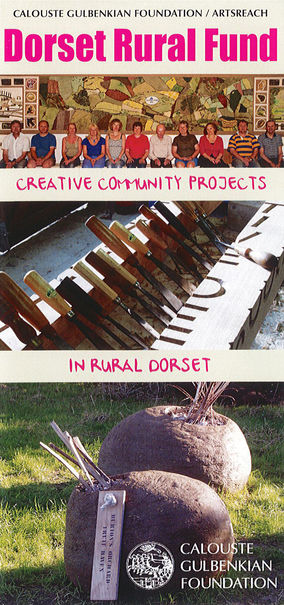Dorset Rural Fund Final Report
Thu 16 Nov 2023
Dorset Rural Fund - the final report
On 30th January 1992 Artsreach received a cheque for £5,000 from the Calouste Gulbenkian Foundation to implement in Dorset their newly formed Rural Arts Policy, with the understanding that should this be a success further tranches of grant funding would be available for use in the County.
Unusually this Policy involved the Foundation devolving its small grant giving functions to local agencies across the country, and Dorset duly planned and set up the Dorset Rural Fund, with its administration based at the Artsreach office in Dorchester.
The first months involved the recruitment of four panel members to plan for the early days of the Fund: Trevor Bailey and Ian Scott had previously conducted research nationally on which the Foundation’s policy had been framed, local artist, librarian, teacher and theatre practitioner Norman Saunders-White had also contributed to this research and they were joined by the then County Arts Officer, Joanna Morland, who had been closely involved in the early days of the development of Artsreach. Joanna was subsequently replaced as a panel member in 1996 by Mike Hoskin when he took over her County Council post and interestingly had experience of a similar Gulbenkian role in neighbouring Somerset.
Just over thirty years later (and a total of £28,000 awarded to Dorset by the Foundation) the Fund Panel made its last grant decision in April 2022, and it seemed a good point at which to reflect on the Fund’s overall achievement, using records at the Artsreach office as a prompt.

The first task was to refine and focus the Foundation’s objectives locally. It was agreed that the Dorset Fund should aim to support all manner of creative projects which reflected the concerns, interests and identity of Dorset communities, taking a very broad view of creative activity. Importantly, and according to instruction from the Foundation, these were not to be artist-led projects. The inspiration for each application should be from the community, with the Fund supporting with costs such as materials and the input of artistic expertise.
It is fair to say that there was a rush of interest at the beginning. Between the autumn of 1992 and a single year later just under 50 applications were made to this new grant-funding source, with a huge diversity of projects suggested, ranging from training of church bell ringers in local peal techniques, an inventor who designed kite based photography methods to assist communities undertake aerial records, support for two scratch choirs (which are very much still going), papier mache giant making workshops to brighten up a village fete, and assistance to a day centre on Portland to create a mural reflecting inter-generational experiences on the Isle, amongst many others. This seemed a very promising start.



Thankfully the Foundation agreed, and the volume of interest from applicants continued such that by the end of 1995, and receipt of a further £5,000 from the Foundation, some 19 grants had been awarded by the local panel, and the Foundation, generally convinced of the merits of its Rural Policy, decided to invest heavily in the further implementation of this across the country. This meant a further £18,000 was then promised to the Dorset Rural Fund over three years, as a farewell grant. Records show that in Dorset in the next year and a half a further 6 awards were made, and by July 2001 a further 15. Amongst these were a community sculpture week in South Perrott, a revival of an historic pageant in Powerstock, an ambitious West Dorset youth dance performance project staged in historic Maumbury Rings in Dorchester, a disability arts project in North Dorset, and tapestry stitchery projects in Beaminster and Sturminster Marshall.
At this point the volume of interest reduced, such that the remaining twenty years of operation only yielded a further 22 grants being made. There was a noticeable falling out of applications around the year 2000, when other similar small-scale grants with less focussed criteria, such as Millenium grants and Awards for All became readily available, and offering larger sums of money (the Dorset Rural Fund was always limited to a £500 maximum grant offer).


However, throughout the life of the Fund very substantial community projects continued to emerge, and though the quantity reduced, the quality did not. Later years produced some very imaginative ideas, including a participatory learners' jazz project, a developing string of community memory projects around the village of Drimpton in West Dorset, expressed through visual art, a locally commissioned song/exhibition and a hand made book recording it all, an open spaces project in Tolpuddle, a ukulele based community opera in the Bridport area, and the foundation of a community radio station in South Dorset, amongst many others.
Fittingly the last grant offered and accepted was for a youth dance project in North Dorset in the summer of 2022, as we all emerged blinking from the previous two years of Covid disruption. One panel member said of this final application that it felt appropriate. "Let’s give the money to some young people and tell them to get on with it…", which they did, and continue to do, in spectacular fashion.
A big thank you to everyone who contributed in some way to the development of this unconventional body of work, and of course to the Calouste Gulbenkian Foundation for enabling it in the first place.
(November 2023)





